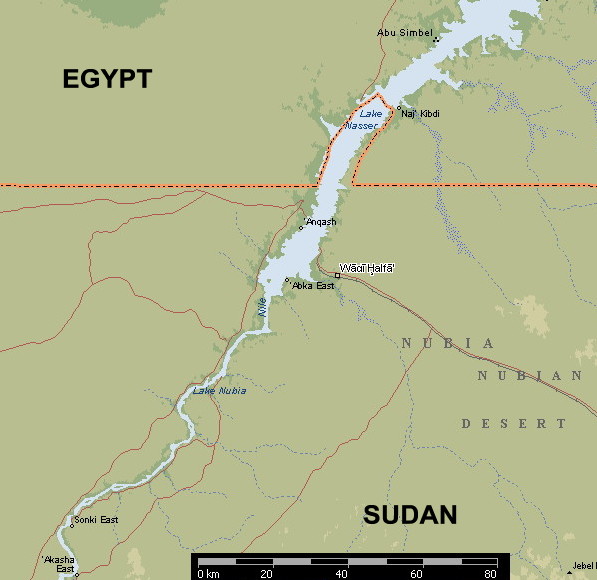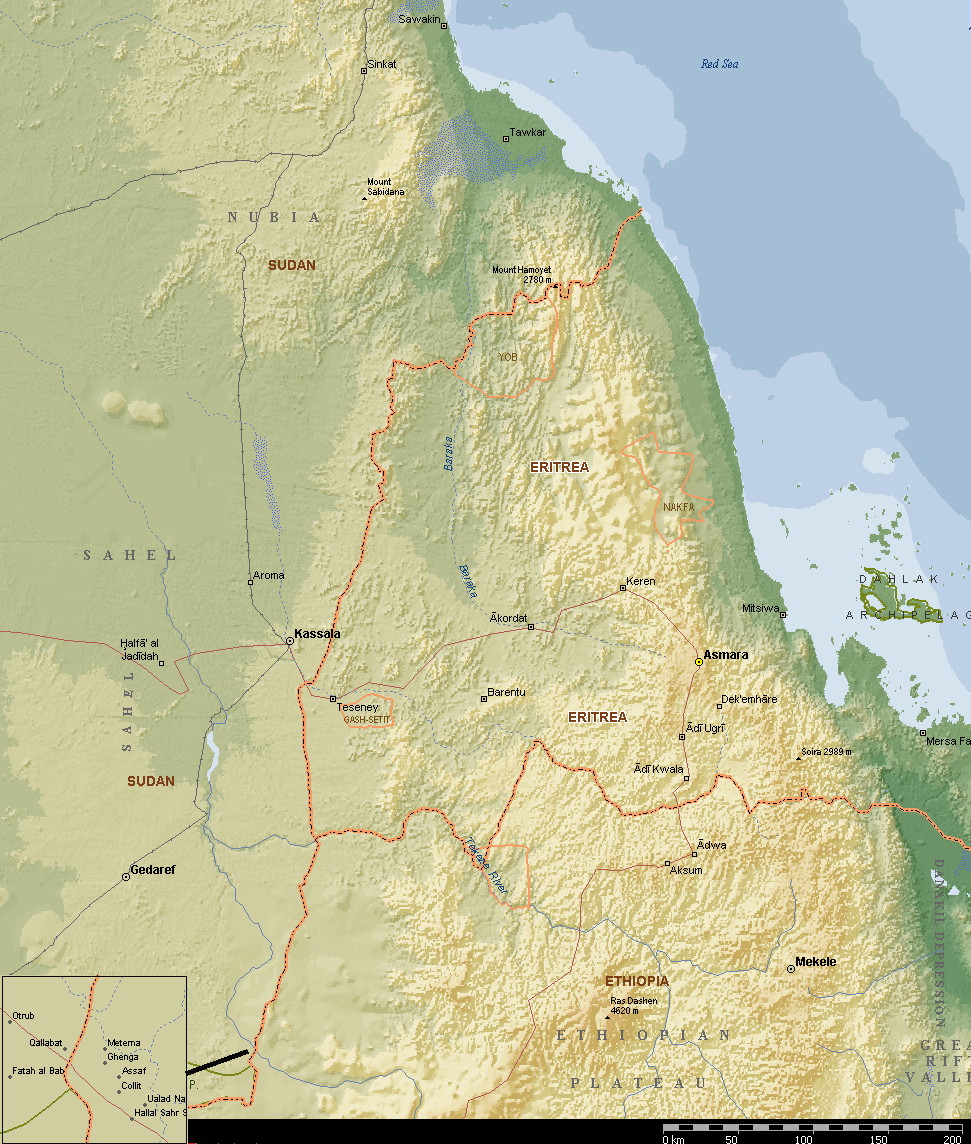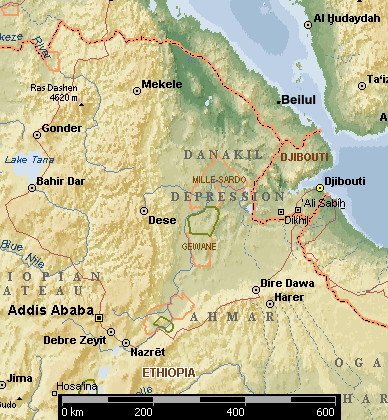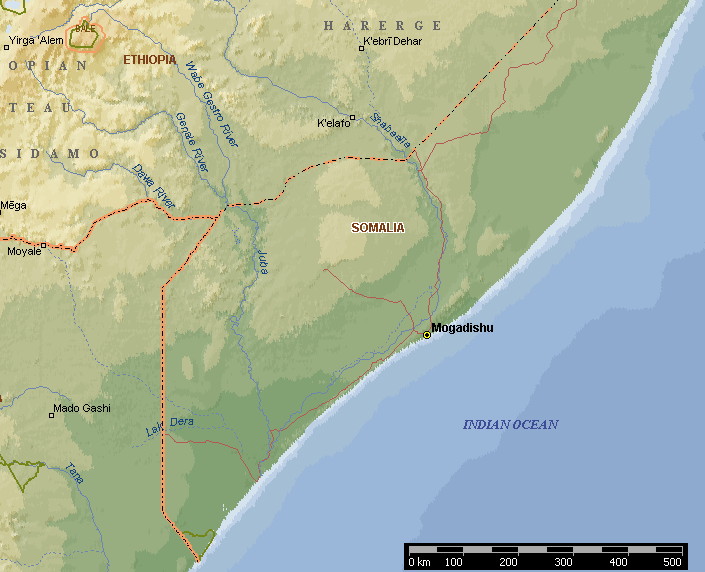Chapter 2 - Geography and History - Northeast Africa - Sudan, Eritrea, Djibouti, Ethiopia & Somalia
| Introduction | The Ants of Africa Chapter 2 - Geography and History - Northeast Africa - Sudan, Eritrea, Djibouti, Ethiopia & Somalia |
|
Colonial era geography In reviewing the original descriptions now (late-2003) made available by the efforts of Donat Agosti, I realised that the geography as understood in the late-19th century was not fully comprehended by modern researchers. For instance, in his great Catalogue, Bolton (1995) has a few instances of type location given as "SUDAN" - this modern students would take as being the large Republic of Sudan, in north-east Africa. Most notably these relate to findings in Santschi (1930a) from collections by Andrieu, near Koulouba (13°29'N 9°08'W, a 100 km or so north-west of Bamako), that is in modern Mali. In the nineteenth century, however, the term "Sudan" also applied to the huge area of French dominated north Africa, stretching from the Atlantic right across to the British-dominated territory, now the modern Sudan.
In my possesssion I have a copy of the Eton Compendium of
Geography, edition published around January 1856, by C.G.N. of
King's College, London; the first edition, by Rev. Aaron Arrowsmith,
having been published in 1831. I have reproduced the relevant pages as
pdfs which can be read by using the links |
||

SudanNote With the independence of Southern Sudan, I have transferred the appropriate notes to the "East Africa" page. Summary of known collectors |
||
|
Notes Northern Saharan areas The earliest record is of specimens from an unnamed collector deposited in the Museum in Vienna, this was Pachycondyla sennaarensis from the area of the old capital Sennar (Mayr, 1862). Mayr (1895) described a single species collected by Dr Ernst Marno, and, Emery (1895) reported a single finding by an unnamed author. Then Mayr (1904b) examined ants collected by L A Jägerskiöld or in most instances by I Trägårdh (who later collected in South Africa, e.g. Santschi, 1914); 16 species or forms were reported [Mayr, G. 1904b. Formiciden aus Ägypten und dem Sudan. In Jägerskiöld, L.A. Results of the Swedish Zoological Expedition to Egypt and the White Nile, 1901, 1, (no. 9): 11 pp. Uppsala]. Santschi (1910) described a new species, Aenictus soudanicus, collected at Toukola by Conan. Other single reports by Santschi were made in 1914; one by an unnamed collector (Santschi, 1914a), one from Lado, Redjaf (5°5' N 31°45' E) by Reichenspeger (Santschi, 1914d); one by Karavaiev from Khartoum (see next paragraph) (Santschi, 1918). V. Karavaiev (1912) collected at least four other species from Khartoum [Karavaiev, V. 1911. Murav'i sobrannye v Egipte i Sudane. Russkoe Entomologicheskoe Obroznie, 11, 1-12]. A small number of species were collected at Port Sudan and appear to be migrants into the port from Arabia or the Mediterranean and are not members of the Sub-Saharan fauna.
Viehmeyer (1923) examined ants collected by F Werner and R Ebner whilst on a 1914 expedition starting and ending in Egypt, with a main study area in Kordofan (Kordufan) to the south-west of Khartoum. [Werner, F., 1919. Wissenschaftliche Ergebnisse der mit Unterstützung der Kaiserlichen Akademie der Wissenschaften in Wien aus der Erbschaft Treitl von F. Werner unternommenen zoologischen Expedition nach dem Anglo-Ägyptischen Sudan (Kordofan) 1914. IV. Bearbeitung der. Fische, Amphibien und Reptilien. Denkschr. Akad. Wiss. Wien 96:437-452.]. Crematogaster nigriceps male and queen specimens were collected from Acacia galls at Dilling, Southern Kordofan, 12° 3' 0N 29° 38' 60 E; 687 m, 22.iii.1914. Santschi (1924) reported a second species collected by Reichensperger; and finally (1933, 1937) reported a few findings from Khartoum and nearby Nile towns, such as Wad Medani, collectors included H H King, H B Johnson & Abdallah. |
||
|
Finzi (1939a) reported two species from Port Sudan, collected by G Muller; Weber (1952) gave two records from the area; and Hamann & Klemm (1967) reported seventeen species from the Wadi Halfa area, essentially typical of the Egyptian fauna; they also cited a couple of findings from Finzi (1936) also from Wadi Halfa. |
||
|
Eastern montane areas Dr Paolo Magretti collected in eastern Sudan and Eritrea; the ants, some 25 species or forms, were identified by Ernesto André (Magretti, 1884). Magretti described how minute his collection efforts were in an area of about two thousand kilometers. In 1883, the year before the uprising against General Gordon, Magretti travelled from the port of Suakin (Sawakin), collecting around the road to Kassala (on Sudanese side of border with Eritrea, not far from Teseny, see above), in the desert plain of Basen and Homrani, on the shore at Gasch, on the verdant banks of the Settit at Takazzie (Gasch-Setit reserve now in Eritrea), and from Bahr el Salaam, ending at the remote Metemma in the Galabat (Gallabat, Ethiopia-Sudan border). Secondly, he returned to Kassala, going via Sennehit, with short stops at Keren, Bogos and returning to Masshua. He had left Suakin at the end of January and was back there on the first of May. A further Magretti specimen was described by Emery (1892) |
||
|
Collections in 2005-2006 and 2009 by Awatif Omer and
co-workers - needs considerable updating Collection localities |
||
 |
||
EritreaSummary of known collectors Notes Finzi (1939a) wrote how fundamental to the study of the ants of Eritrea were publications by Forel in 1910 and Emery in 1915. The first reported collections were by Beccari, as entomologist on an expedition to the Bogos region, and identified by Emery (1877b); also listed in that paper were ants from Egypt and Yemen (Aden) collected by Antinori and Issel. Professor K Escherisch, mainly from Ghinda and Nefassit (Forel, 1894b, & Forel, 1910c). Next was Professor F. Silvestri, whose great survey also covered West Africa (Emery, 1915g). Emery noted how Prof. Silvestri collected 70 species, subspecies and varieties in the brief period of 23 August to 9 September 1914, yielding 12 new forms and 20 new distribution records for the area. Forel, 1910c) included Nefassit (or Nefasit, just east of Asmara, Lat 15.3333333; Long 39.0619444). Emery (1881b) reported collections by G Doria & O Beccari, on the motor yacht "Esloratore" when it was forced to seek shelter at Massaua on 22 December 1879 and called at Assab on 25 December. Added to those were the research of Vittorio Belli, Andreini and a few others (Paolo Magretti, C Mancini & P Ruggeri) - all reported by Emery (1892a; and [in] 1901e). Finzi himself reported collections by Professor Giuseppe Müller made between December 1934 and January 1935. The main locations were - Asmara; Massua = modern Mitsiwa the port city of Eritrea; Saati some 20 km inland on road to Asmara; Ghinda ?; Keren area. Muller - Agordat (Akordat), Tessenei (Teseney), Maitzada & Barentu, Setit, Omager. |
||
DjiboutiSummary of known collectors |
||

EthiopiaSummary of known collectors Notes A work published under the auspices of the French government, Charlemagne Théophile Lefebvre, 1811-1860. Voyage en Abyssinie: Exécuté pendant les Années 1839, 1840, 1841, 1842, 1843, par une Commission Scientifique Composée de Théophile Lefebvre, A. Petit et Quartin-Dillon, Vignaud; Publié par Ordre du Roi, Sous les Auspices de le Vice-Amiral Baron de Mackau, Ministre de la Marine. Paris: Arthus Bertrand, Libraire de la Société de Géographie, 1845-1851. Travelled from Tigray to Shoa. GUÉRIN-MÉNEVILLE F.E., 1849.- Insectes. including Ordre des Orthoptères. p. 333-339. Forel (1892a, 1894b) described specimens collected in "Südabessinien" by Herr Ingenieur Alfred Ilg, Counsellor to King Menilek. The locations from which material came seem to have been Harar, Schoa and the northern "Thiel" of Somaliland. Forel (1907c) described specimens collected by Baron Maurice de Rothschild in 1905, apparently on a journey crossing Ethiopia and ending in Kenya. [see Simon, E. 1909b. Voyage de M. Maurice de Rothschild en Ethiopie et dans l'Afrique orientale anglaise (1904-1906). Arachnides 1. Part. Annales de la Société Entomologique Belge, 53, 29-43.] Menozzi (1931a) reported a small number of ants collected by Baron Raimondo Franchetti in the Danakil Depression (Dancalia) Ethiopia on his 1929 expedition involving a caravan formed from a hundred men and as many camel. That crossed the Dancalia, a geographic area that is one of the most torrid and inhospitable of the earth, with temperatures reaching up 60° C), through the Depression at 120 m below sea level, from east to the west, from Beilul, on the Red Sea, to Mekele (Macallé) - see http://www.cigv.it/gallery/Il-tempo-che-fu".
Not in HNS is Reichensperger, A.1913: Zool. Jb 35(2): 214 on Myrmecophila
meneliki n.sp. (Gryllodea) found at Harrar (= Harer), Harerge,
Ethiopia, Africa 42°07'00'' O 09°18'59'' N, with various ants - Menozzi (1939c) reviewed ants collected by Professor E Zavattari in the semi-desert southern of the Borana people. The main places named were Amba Mussolini (Ganale Doria, 12.iii.1937), Malca Guba (Melka Guba, 4°47'N 39°22'E; 18-19.iii.1937), Neghelli (Negele, 5°20'N 39°34'E, 8-10-14 & 24-26-30.iii.1937 & 2-4.vi.1937), Arero (4°44'N 38°48'E, 8-9-10.iv.1937, 24.iv.1937), Javello (16-18-22-29-30.iv.1937), Mega (4°03'N 38°18'E, 4-6-7-8.v.1937), Moyale (3°31'N 39°02'E, 9-15-16-20.v.1937). Djem-Djem Forest is some 60 km due west of Addis Ababa, collection of Monomorium crawleyi by Hugh Scott in 1926, see Scott's paper on mosquitoes, travelling with J Omer Cooper. |
||

SomaliaSummary of known collectors Notes Forel (1892b, 1892d) reported ant identifications from the work of Professor Dr Conrad Keller while on the Prince Eugenio Ruspoli Expedition in August to September 1891. No locations were given. V Bottego made collections of ants while on one or two expeditions in the mid-1890's (Vanutelli & Citerni, 1899, Seconda Spedizione Bottego, L'Omo; R Gestro appears to have identified ants - e.g. Terataner bottego, p 626, fig 19). The main identifications were by Emery (1895a, 1896i, 1899a). The first paper is titled - "Exploration of the Giuba [Juba] from the mouth to the head, during the years 1892-1893, under the auspices of the Italian Geographical Society". The headwaters of the Ganale River (Upper Ganale), however, are in Ethiopia. Places in the 1899 paper, e.g Dime are in Southern Ethiopia, just north of Lake Turkana (probably "Lake Omo" or "Lago Bass Narok"). Menozzi provided a short series of papers identifying ants. In Menozzi (1926a), he covered material collected on two expeditions, the Stefanini-Paoli Mission of 1913 and the Stefanini-Puccioni Mission of 1924. A total of 15 species were recognised. Locations listed were Mogadishu; Burbisciara; Obbia Durgane (Sultanate of Obbia); Uel Dine; Uanle; Mahaddei; Magghiole; Bar Maedghe; Giglei; El Bar El Ellan ; Berdale; Hongolo, Ina Oschin (altiplano, Sultanate of Migiurtini); Balli Igole; Audurgab. Menozzi (1927f) reviewed ants collected mostly in the Juba Valley by Saverio Patrizi. The prime locations were Belet Amin & Bidi Scionde, also Jach Sciomo and Fungalango. A few specimens from North East Kenya, and at Fort Hall and Waju were included. Menozzi (1930b) identified 54 species (three totally new, one
new subspecies and one new variety); the collectors were Professor
Guido Paoli and Dr Alfonso Chiaromonte, who visited central
(meridonale) Italian Somalia in 1926. A particular feature was the
interest of Prof Paoli in the inhabiters of spines of Acacia
trees, primarily A. fistula Schweinf. and A. bussei
Harms. At that time the main if not sole mutualism was thought to
involve Crematogaster gerstaeckeri. After Paoli's studies the
list of Acacia inhabiters was expanded to (modern names) - |
|
©2004, 2006, 2009, 2011, 2012 - Brian Taylor CBiol
FSB FRES 11, Grazingfield, Wilford, Nottingham, NG11 7FN, U.K. |
href="history9.htm"